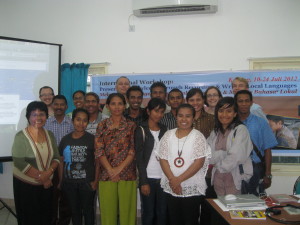Community Collaboration
Recordings may take place at speakers’ homes, at community centers, at ELA’s office, or elsewhere—most of the speakers we work with are from the New York/New Jersey area, but ELA is also a center for endangered language work more broadly.
Our documentation efforts at ELA are aimed at languages with very little in the way of recorded or written materials, either in the language or about the language. One of our goals is thus to record culturally significant texts that can be shared with the language group or more widely with the public. We focus on supplementing the documentary record for endangered languages–in many cases, ELA linguists are making the first-ever multimedia recordings of a given language—and responding to the needs and requests of communities. While the highest priority for a language’s survival must be transmission, in the worst case scenario, high quality annotated recordings can ultimately put a language on “life support” as we find with the many documentary materials being used for language reclamation across the globe today. Our primary aim however is not to pickle language in case of future catastrophe, it is to make these recordings useful for today’s generation of language learners, linguists and others.
The opportunity of working with hundreds of language communities in New York City is tempered by certain challenges. Unlike in traditional “fieldwork”, in several cases we do not have access to more than a single speaker of a language, as they may be the only local representatives of their language community. Our corpus of recordings in these cases is necessarily unbalanced, lacking dialogue and inter-speaker variation. On the other hand, in depth documentation of a single speaker’s knowledge of his or her language still constitutes a very significant contribution for a language that has never been carefully documented. This raises an interesting question of whether languages can be properly documented and understood outside of their traditional area. We would answer this question with an emphatic “yes” for the following reasons. While the connection between land and language cannot and should not be denied, there are many components of a language that are more computational than cultural, for instance, how a language forms relative clauses or the way certain speech sounds pattern within words. Secondly, the false dichotomy of “local languages” versus “world languages” puts unnatural strictures on indigenous languages that nobody would think of imposing on languages such as English, Chinese, Russian or French, all routinely studied outside their homelands. In effect, it reenforces the detrimental idea that certain languages are not fully appropriate outside their villages. Finally, small communities routinely reconstitute their cultures in New York City; there are, in fact, several well-known cases where languages have been preserved only outside the homeland. In sum, while we recognize that languages co-evolve with their surroundings we also give much credit to the resilience of languages and cultures in diaspora.

The communities we typically work with are “minorities within minorities”: people who are minorities in their places of origin whose compatriots form a minority community in New York. The ethno-linguistic identities of these groups in New York are often not even recognized by others from their country. For example, the Amuzgo people of Guerrero and Oaxaca states in Mexico speak one of over 250 indigenous languages that exist in Mexico, but few Mexicans from outside the immediate Amuzgo-speaking area have ever heard of the Amuzgo people or their language.
We are often asked how ELA makes contact with speakers of indigenous and endangered languages. Finding such “doubly minoritized” communities in New York is usually not straightforward and must rely to a large extent on chance and indeed the element of chance never ceases to surprise us. To take but two examples, not long after researcher Natalia Bermudez returned from her fieldwork in Panama with the Naso and Ngobe, we were contacted by one of only two individuals from the related Bribri tribe living in the United States. Similarly, after an article about our work appeared in the New York Times, we were contacted by the only known speaker of Tsou in the United States, an endangered Austronesian language of Taiwan with roughly 2,000 speakers.
To make contact, we post flyers, advertise through community radio, get plugged into community and neighborhood networks, and talk to people at fairs and other celebrations. In many cases, individuals contact us after having heard about us in the press or after hearing about or attending one of our public events. Most often, our collaborators will introduce us to related communities in the local area and thus our network grows.
ELA collaborates with interested individuals and organizations from across the city on a variety of language projects and has been successful in procuring grants for fieldwork on endangered languages abroad. ELA also has close ties to the Endangered Language Initiative at the CUNY Graduate Center, is engaged in film and poetry projects, and is assisting with programming at NYC museums and cultural centers.